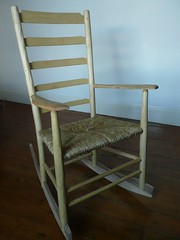I love looking at examples of other people's woodworking, almost as much as I enjoy making stuff myself. It's great to look closely at a piece of work, to see the tool marks and through them, the decisions the craftsman made in carving the piece. By looking critically at other's work, trying to understand why they did what they did is a way to making yourself better at your craft.
1
David Fisher Bowl
Really I could put all of David Fisher's bowls here, as well as his
awesome shave horse, and be quite happy with that. I love the lines of this bowl, the symmetry and the curves. The tool marks on the inside shows that he was always carving down into the centre of the bowl, whereas I tend to carve longways, from one end to the other.
2
Barn Spoon
This is the spoon I bought from Barn. It's a fantastically functional spoon. A friend commented that it was a lot more simple than the spoons I create. However the consistency of shape, the sharpness of the lines shows the true talent that went into this spoon.
3
Robin Wood Porringer
I have two of Robin's porringer bowls that see daily use. They're great to hold plus wonderful to look at.
4
Sean Hellman Shrink Pot
All of Sean's shrink pots are fantastic, as are the lids he adds to them. The shape of this one really appeals to me, as does the complexity of the decorated lid.
5
David Fisher Bowl
Another of David's great bowls. The sheer size of this walnut bowl is what strikes me first about this piece. Like all of his work, the lines are so neat, the shape so perfect, it's a great thing to strive for.
6
Robin Wood Quaich
If it wasn't for these wonderful creations being a little out of my price range I think I would have all my drinks out of these. The collaboration with the silversmith to add the rim makes these Scottish drinking vessels look more like jewellery than a cup.
7
Steve Tomlin Chair
It just looks so comfortable. Again, it's simple design that draws me to this. As with Barn's spoon, simple designs can hide the skill of the craftsman. This wonderful chair could look like some sticks, planks and a bit of reed to a layman, but the balance of shape, space and form come together brilliantly in an item that is brilliantly functional and no-doubt built to last.
8 Janharm ter Brugg Spoon
I rarely try to decorate my spoons with kolrossing, but when it is done well it brings an otherwise plain spoon to a new level of beauty. Janharm will be back at
Spoonfest this year teaching his engraving techniques and I hope to be able to get on one of his courses. In the meantime I'll keep practising on scrap wood so as not to ruin an otherwise good spoon,
9 Fritiof Spoon
Fritiof's spoons are easily recognised by the parallel lines running along the bowl. I've tried this technique for myself, but don't feel as though it suits my spoons. On his spoons however, the lines work perfectly, almost creating the impression of movement along the bowl.
10
Simon Hill Spoon
This is the spoon I received from Simon Hill as part of the International Secret Spoon Swap. 120 people signed up to have their names drawn from a hat to send and receive a spoon from other members of the
Spoon Carving, Green Woodworking and Sloyd group on Facebook. The delicate chip carving on the handle and the way the lines meet on the neck make this a brilliant spoon.
What pieces of work do you draw inspiration from? Let me know in the comments section.





















































